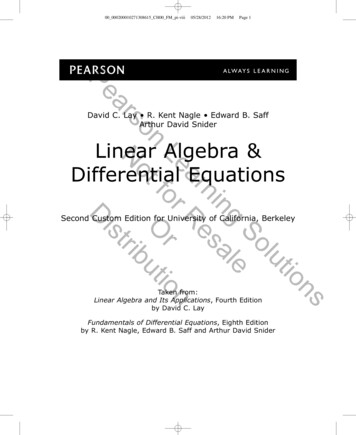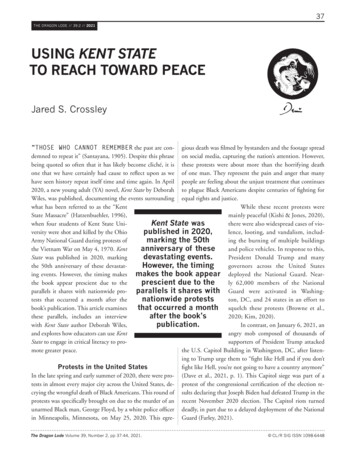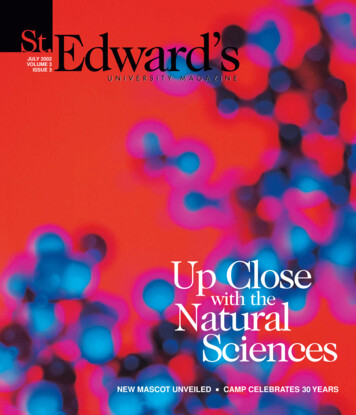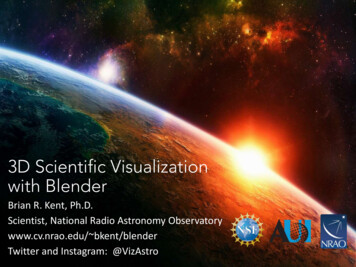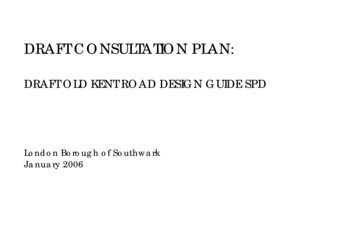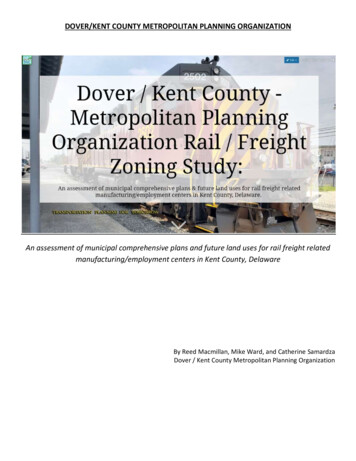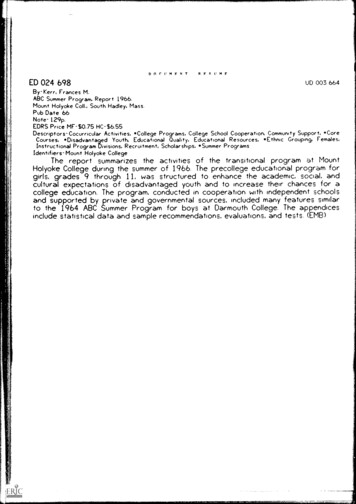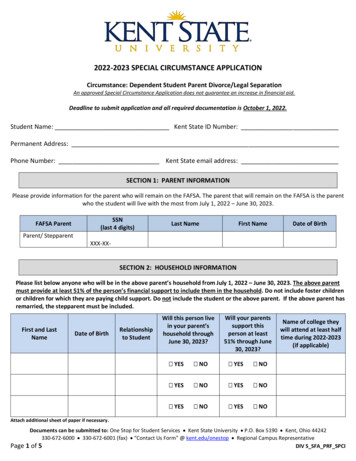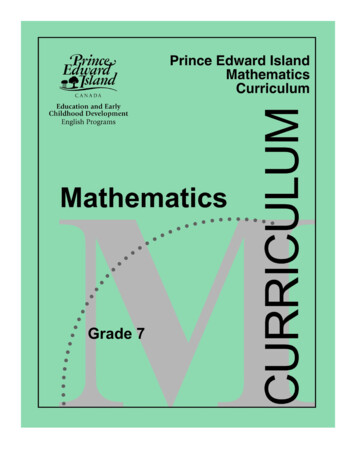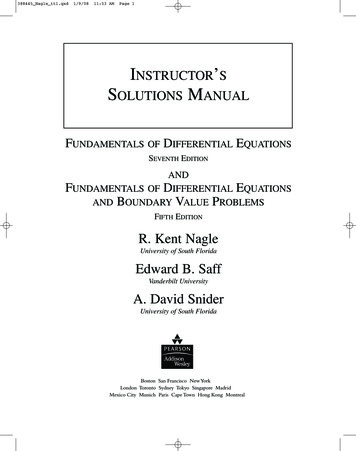
Transcription
388445 Nagle ttl.qxd1/9/0811:53 AMPage 1INSTRUCTOR’SSOLUTIONS MANUALFUNDAMENTALS OF DIFFERENTIAL EQUATIONSSEVENTH EDITIONANDFUNDAMENTALS OF DIFFERENTIAL EQUATIONSAND BOUNDARY VALUE PROBLEMSFIFTH EDITIONR. Kent NagleUniversity of South FloridaEdward B. SaffVanderbilt UniversityA. David SniderUniversity of South Florida
388445 Nagle ttl.qxd1/9/0811:53 AMPage 2This work is protected by United States copyright laws and is provided solelyfor the use of instructors in teaching their courses and assessing studentlearning. Dissemination or sale of any part of this work (including on theWorld Wide Web) will destroy the integrity of the work and is not permitted. The work and materials from it should never be made available tostudents except by instructors using the accompanying text in theirclasses. All recipients of this work are expected to abide by theserestrictions and to honor the intended pedagogical purposes and the needs ofother instructors who rely on these materials.Reproduced by Pearson Addison-Wesley from electronic files supplied by the author.Copyright 2008 Pearson Education, Inc.Publishing as Pearson Addison-Wesley, 75 Arlington Street, Boston, MA 02116.All rights reserved. No part of this publication may be reproduced, stored in a retrieval system, or transmitted, in any form or by any means, electronic, mechanical, photocopying, recording, or otherwise, without the prior written permission of the publisher.ISBN-13: 978-0-321-38844-5ISBN-10: 0-321-38844-5
ContentsNotes to the InstructorSoftware Supplements. . . . . . . . . . . . .Computer Labs. . . . . . . . . . . . . . . .Group Projects . . . . . . . . . . . . . . . . .Technical Writing Exercises . . . . . . . . . .Student Presentations . . . . . . . . . . . . .Homework Assignments . . . . . . . . . . . .Syllabus Suggestions . . . . . . . . . . . . . .Numerical, Graphical, and Qualitative MethodsEngineering/Physics Applications. . . . . .Biology/Ecology Applications . . . . . . . . . . .Supplemental Group Projects9Detailed Solutions & Answers to Even-Numbered ProblemsCHAPTER 1 IntroductionExercises 1.1 Detailed Solutions.Exercises 1.2 Detailed Solutions.Exercises 1.3 Detailed Solutions.Exercises 1.4 Detailed Solutions.Tables . . . . . . . . . . . . . . . .Figures. . . . . . . . . . . . . . .11122233457.CHAPTER 2 First Order Differential EquationsExercises 2.2 Detailed Solutions. . . . . . . . . . .Exercises 2.3 Detailed Solutions. . . . . . . . . . .Exercises 2.4 Detailed Solutions. . . . . . . . . . .Exercises 2.5 Detailed Solutions. . . . . . . . . . .Exercises 2.6 Detailed Solutions. . . . . . . . . . .Review Problems Answers. . . . . . . . . . . . . .Tables . . . . . . . . . . . . . . . . . . . . . . . . . .Figures. . . . . . . . . . . . . . . . . . . . . . . . .17.17171822252829.353541485661707171iii
CHAPTER 3Mathematical Models and Numerical MethodsInvolving First Order EquationsExercises 3.2 Detailed Solutions. . . . . . . . . . . . . . . . . . .Exercises 3.3 Detailed Solutions. . . . . . . . . . . . . . . . . . .Exercises 3.4 Detailed Solutions. . . . . . . . . . . . . . . . . . .Exercises 3.5 Answers . . . . . . . . . . . . . . . . . . . . . . . . .Exercises 3.6 Answers . . . . . . . . . . . . . . . . . . . . . . . . .Exercises 3.7 Answers . . . . . . . . . . . . . . . . . . . . . . . . .Tables . . . . . . . . . . . . . . . . . . . . . . . . . . . . . . . . . .Figures. . . . . . . . . . . . . . . . . . . . . . . . . . . . . . . . .CHAPTER 4 Linear Second OrderExercises 4.1 Detailed Solutions. .Exercises 4.2 Detailed Solutions. .Exercises 4.3 Detailed Solutions. .Exercises 4.4 Detailed Solutions. .Exercises 4.5 Detailed Solutions. .Exercises 4.6 Detailed Solutions. .Exercises 4.7 Detailed Solutions. .Exercises 4.8 Detailed Solutions. .Exercises 4.9 Detailed Solutions. .Exercises 4.10 Detailed Solutions . .Review Problems Answers. . . . .Figures. . . . . . . . . . . . . . . .ivEquations. . . . . . . . . . . . . . . . . . . . . . . . . . . . . . . . . . . . . . . . . . . . . . . . . . . . . . . . . . . . . . . . . . . . . . . . .CHAPTER 5 Introduction to SystemsExercises 5.2 Answers . . . . . . . . . .Exercises 5.3 Answers . . . . . . . . . .Exercises 5.4 Answers . . . . . . . . . .Exercises 5.5 Answers . . . . . . . . . .Exercises 5.6 Answers . . . . . . . . . .Exercises 5.7 Answers . . . . . . . . . .Exercises 5.8 Answers . . . . . . . . . .Review Problems Answers. . . . . . .Tables . . . . . . . . . . . . . . . . . . .Figures. . . . . . . . . . . . . . . . . .and. . . . . . . . . . . . . . . . . . . . .CHAPTER 6Exercises 6.1Exercises 6.2Exercises 6.3Exercises 6.4Linear Differential. . . . . . . . . . . . . . . . . . . . . . . . . . . . . . . . . . . . . . . . . . . . .Theory of Higher-OrderAnswers . . . . . . . . . .Answers . . . . . . . . . .Answers . . . . . . . . . .Answers . . . . . . . . . .Phase. . . . . . . . . . . . . . . . . . . . . . . . . . . . . . .Plane Analysis. . . . . . . . . . . . . . . . . . . . . . . . . . . . . . . . . . . . . . . . . . . . . . . . . . . . . . . . . . . . . . . . . . . . . . . . . . . . . . . . . . . . . . . . . . .Equations. . . . . . . . . . . . . . . . . . . . . . . . 3194194195
Review Problems Answers. . . . . . . . . . . . . . . . . . . . . . . . . . . . 196CHAPTER 7 Laplace TransformsExercises 7.2 Detailed Solutions.Exercises 7.3 Detailed Solutions.Exercises 7.4 Detailed Solutions.Exercises 7.5 Detailed Solutions.Exercises 7.6 Detailed Solutions.Exercises 7.7 Detailed Solutions.Exercises 7.8 Detailed Solutions.Exercises 7.9 Detailed Solutions.Review Problems Answers. . . .Figures. . . . . . . . . . . . . . .CHAPTER 8 Series Solutions of DifferentialExercises 8.1 Answers . . . . . . . . . . . . . .Exercises 8.2 Answers . . . . . . . . . . . . . .Exercises 8.3 Answers . . . . . . . . . . . . . .Exercises 8.4 Answers . . . . . . . . . . . . . .Exercises 8.5 Answers . . . . . . . . . . . . . .Exercises 8.6 Answers . . . . . . . . . . . . . .Exercises 8.7 Answers . . . . . . . . . . . . . .Exercises 8.8 Answers . . . . . . . . . . . . . .Review Problems Answers. . . . . . . . . . .Figures. . . . . . . . . . . . . . . . . . . . . .CHAPTER 9 Matrix MethodsExercises 9.1 Answers . . . . .Exercises 9.2 Answers . . . . .Exercises 9.3 Answers . . . . .Exercises 9.4 Answers . . . . .Exercises 9.5 Answers . . . . .Exercises 9.6 Answers . . . . .Exercises 9.7 Answers . . . . .Exercises 9.8 Answers . . . . .Review Problems Answers. .Figures. . . . . . . . . . . . .for Linear. . . . . . . . . . . . . . . . . . . . . . . . . . . . . . . . . . . . . . . . . . . . . . . . . . . . . . . . . . . . .Equations. . . . . . . . . . . . . . . . . . . . . . . . . . . . . . . . . . . . . . . . . . . . . . . . . . . . . . . . . . . . .Systems. . . . . . . . . . . . . . . . . . . . . . . . . . . . . . . . . . . . . . . . . . . . . . . . . . 90CHAPTER 10 Partial Differential Equations291Exercises 10.2 Answers. . . . . . . . . . . . . . . . . . . . . . . . . . . . . . 291Exercises 10.3 Answers. . . . . . . . . . . . . . . . . . . . . . . . . . . . . . 291Exercises 10.4 Answers. . . . . . . . . . . . . . . . . . . . . . . . . . . . . . 292v
Exercises 10.5 AnswersExercises 10.6 AnswersExercises 10.7 Answers. . . . . . . . . . . . . . . . . . . . . . . . . . . . . . 293. . . . . . . . . . . . . . . . . . . . . . . . . . . . . . 294. . . . . . . . . . . . . . . . . . . . . . . . . . . . . . 295CHAPTER 11 EigenvalueExercises 11.2 Answers.Exercises 11.3 Answers.Exercises 11.4 Answers.Exercises 11.5 Answers.Exercises 11.6 Answers.Exercises 11.7 Answers.Exercises 11.8 Answers.Review Problems AnswersProblems and Sturm-Liouville. . . . . . . . . . . . . . . . . . . . . . . . . . . . . . . . . . . . . . . . . . . . . . . . . . . . . . . . . . . . . . . . . . . . . . . . . . . . . . . . . . . . . . . . . . . . . . . . . . . . . . . . . . . . . . . . . . . . . . . . . . . . . . . . . . . . . . . . . . . . . . . . . . . . . . . .CHAPTER 12 Stability of AutonomousExercises 12.2 Answers. . . . . . . . . .Exercises 12.3 Answers. . . . . . . . . .Exercises 12.4 Answers. . . . . . . . . .Exercises 12.5 Answers. . . . . . . . . .Exercises 12.6 Answers. . . . . . . . . .Exercises 12.7 Answers. . . . . . . . . .Review Problems Answers. . . . . . . .Figures. . . . . . . . . . . . . . . . . . .Systems. . . . . . . . . . . . . . . . . . . . . . . . . . . . . . . . . . . . . . . . .CHAPTER 13 Existence and UniquenessExercises 13.1 Answers. . . . . . . . . . .Exercises 13.2 Answers. . . . . . . . . . .Exercises 13.3 Answers. . . . . . . . . . .Exercises 13.4 Answers. . . . . . . . . . .Review Problems Answers. . . . . . . . .viTheory. . . . . . . . . . . . . . . . . . . . .Equations. . . . . . . . . . . . . . . . . . . . . . . . . . . . . . . . . . . . . . . . . . . . . . . . 308309.317317317318318318
Notes to the InstructorOne goal in our writing has been to create flexible texts that afford the instructor a varietyof topics and make available to the student an abundance of practice problems and projects.We recommend that the instructor read the discussion given in the preface in order to gainan overview of the prerequisites, topics of emphasis, and general philosophy of the text.Software SupplementsInteractive Differential Equations CD-ROM: By Beverly West (Cornell University),Steven Strogatz (Cornell University), Jean Marie McDill (California Polytechnic State University – San Luis Obispo), John Cantwell (St. Louis University), and Hubert Hohn (Massachusetts College of Arts) is a popular software directly tied to the text that focuses on helpingstudents visualize concepts. Applications are drawn from engineering, physics, chemistry, andbiology. Runs on Windows or Macintosh and is included free with every book.Instructor’s MAPLE/MATHLAB/MATHEMATICA manual: By Thomas W. Polaski (Winthrop University), Bruno Welfert (Arizona State University), and Maurino Bautista(Rochester Institute of Technology). A collection of worksheets and projects to aid instructors in integrating computer algebra systems into their courses. Available via Addison-WesleyInstructor’s Resource Center.MATLAB Manual ISBN 13: 978-0-321-53015-8; ISBN 10: 0-321-53015-2MAPLE Manual ISBN 13: 978-0-321-38842-1; ISBN 10: 0-321-38842-9MATHEMATICA Manual ISBN 13: 978-0-321-52178-1; ISBN 10: 0-321-52178-1Computer LabsA computer lab in connection with a differential equations course can add a whole new dimension to the teaching and learning of differential equations. As more and more collegesand universities set up computer labs with software such as MAPLE, MATLAB, DERIVE,MATHEMATICA, PHASEPLANE, and MACMATH, there will be more opportunities to include a lab as part of the differential equations course. In our teaching and in our texts, wehave tried to provide a variety of exercises, problems, and projects that encourage the studentto use the computer to explore. Even one or two hours at a computer generating phase planediagrams can provide the students with a feeling of how they will use technology together1
with the theory to investigate real world problems. Furthermore, our experience is that theythoroughly enjoy these activities. Of course, the software, provided free with the texts, isespecially convenient for such labs.Group ProjectsAlthough the projects that appear at the end of the chapters in the text can be workedout by the conscientious student working alone, making them group projects adds a socialelement that encourages discussion and interactions that simulate a professional work placeatmosphere. Group sizes of 3 or 4 seem to be optimal. Moreover, requiring that each individualstudent separately write up the group’s solution as a formal technical report for grading bythe instructor also contributes to the professional flavor.Typically, our students each work on 3 or 4 projects per semester. If class time permits, oralpresentations by the groups can be scheduled and help to improve the communication skillsof the students.The role of the instructor is, of course, to help the students solve these elaborate problems ontheir own and to recommend additional reference material when appropriate.Some additional Group Projects are presented in this guide (see page 9).Technical Writing ExercisesThe technical writing exercises at the end of most chapters invite students to make documentedresponses to questions dealing with the concepts in the chapter. This not only gives studentsan opportunity to improve their writing skills, but it helps them organize their thoughts andbetter understand the new concepts. Moreover, many questions deal with critical thinkingskills that will be useful in their careers as engineers, scientists, or mathematicians.Since most students have little experience with technical writing, it may be necessary to returnungraded the first few technical writing assignments with comments and have the students redothe the exercise. This has worked well in our classes and is much appreciated by the students.Handing out a “model” technical writing response is also helpful for the students.Student PresentationsIt is not uncommon for an instructor to have students go to the board and present a solution2
to a problem. Differential equations is so rich in theory and applications that it is an excellentcourse to allow (require) a student to give a presentation on a special application (e.g., almostany topic from Chapter 3 and 5), on a new technique not covered in class (e.g., material fromSection 2.6, Projects A, B, or C in Chapter 4), or on additional theory (e.g., material fromChapter 6 which generalizes the results in Chapter 4). In addition to improving students’communication skills, these “special” topics are long remembered by the students. Here, too,working in groups of 3 or 4 and sharing the presentation responsibilities can add substantiallyto the interest and quality of the presentation. Students should also be encouraged to enliventheir communication by building physical models, preparing part of their lectures on videocassette, etc.Homework AssignmentsWe would like to share with you an obvious, non-original, but effective method to encouragestudents to do homework problems.An essential feature is that it requires little extra work on the part of the instructor or grader.We assign homework problems (about 10 of them) after each lecture. At the end of the week(Fridays), students are asked to turn in their homework (typically, 3 sets) for that week. Wethen choose at random one problem from each assignment (typically, a total of 3) that willbe graded. (The point is that the student does not know in advance which problems will bechosen.) Full credit is given for any of the chosen problems for which there is evidence that thestudent has made an honest attempt at solving. The homework problem sets are returned tothe students at the next meeting (Mondays) with grades like 0/3, 1/3, 2/3, or 3/3 indicatingthe proportion of problems for which the student received credit. The homework grades aretallied at the end of the semester and count as one test grade. Certainly, there are variationson this theme. The point is that students are motivated to do their homework with littleadditional cost ( time) to the instructor.Syllabus SuggestionsTo serve as a guide in constructing a syllabus for a one-semester or two-semester course, theprefaces to the texts list sample outlines that emphasize methods, applications, theory, partialdifferential equations, phase plane analysis, computation, or combinations of these. As afurther guide in making a choice of subject matter, we provide below a listing of text materialdealing with some common areas of emphasis.3
Numerical, Graphical, and Qualitative MethodsThe sections and projects dealing with numerical, graphical, and qualitative techniques ofsolving differential equations include:Section 1.3: Direction FieldsSection 1.4: The Approximation Method of EulerProject A for Chapter 1: Taylor SeriesProject B for Chapter 1: Picard’s MethodProject D for Chapter 1: The Phase LineSection 3.6: Improved Euler’s Method, which includes step-by-step outlines of the improved Euler’s method subroutine and improved Euler’s method with tolerance. Theseoutlines are easy for the student to translate into a computer program (cf. pages 135and 136).Section 3.7: Higher-Order Numerical Methods : Taylor and Runge-Kutta, which includesoutlines for the Fourth Order Runge-Kutta subroutine and algorithm with tolerance (seepages 144 and 145).Project H for Chapter 3: Stability of Numerical MethodsProject I for Chapter 3: Period Doubling an ChaosSection 4.8: Qualitative Considerations for Variable Coefficient and Nonlinear Equations, which discusses the energy integral lemma, as well as the Airy, Bessel, Duffing,and van der Pol equations.Section 5.3: Solving Systems and Higher-Order Equations Numerically, which describesthe vectorized forms of Euler’s method and the Fourth Order Runge-Kutta method, anddiscusses an application to population dynamics.Section 5.4: Introduction to the Phase Plane, which introduces the study of trajectoriesof autonomous systems, critical points, and stability.4
Section 5.8: Dynamical Systems, Poincarè Maps, and Chaos, which discusses the use ofnumerical methods to approximate the Poincarè map and how to interpret the results.Project A for Chapter 5: Designing a Landing System for Interplanetary TravelProject B for Chapter 5: Things That BobProject D for Chapter 5: Strange Behavior of Competing Species – Part IProject D for Chapter 9: Strange Behavior of Competing Species – Part IIProject D for Chapter 10: Numerical Method for u f on a RectangleProject D for Chapter 11: Shooting MethodProject E for Chapter 11: Finite-Difference Method for Boundary Value ProblemsProject C for Chapter 12: Computing Phase Plane DiagramsProject D for Chapter 12: Ecosystem of Planet GLIA-2Appendix A: Newton’s MethodAppendix B: Simpson’s RuleAppendix D: Method of Least SquaresAppendix E: Runge-Kutta Procedure for EquationsThe instructor who wishes to emphasize numerical methods should also note that the textcontains an extensive chapter of series solutions of differential equations (Chapter 8).Engineering/Physics ApplicationsSince Laplace transforms is a subject vital to engineering, we have included a detailed chapteron this topic – see Chapter 7. Stability is also an important subject for engineers, so wehave included an introduction to the subject in Chapter 5.4 along with an entire chapteraddressing this topic – see Chapter 12. Further material dealing with engineering/physicapplications include:Project C for Chapter 1: Magnetic “Dipole”5
Project B for Chapter 2: Torricelli’s Law of Fluid FlowSection 3.1: Mathematical ModelingSection 3.2: Compartmental Analysis, which contains a discussion of mixing problemsand of population models.Section 3.3: Heating and Cooling Buildings, which discusses temperature variations inthe presence of air conditioning or furnace heating.Section 3.4: Newtonian MechanicsSection 3.5: Electrical CircuitsProject C for Chapter 3: Curve of PursuitProject D for Chapter 3: Aircraft Guidance in a CrosswindProject E for Chapter 3: Feedback and the Op AmpProject F for Chapter 3: Band-Bang ControlsSection 4.1: Introduction: Mass-Spring OscillatorSection 4.8: Qualitative Considerations for Variable-Coefficient and Nonlinear EquationsSection 4.9: A Closer Look at Free Mechanical VibrationsSection 4.10: A Closer Look at Forced Mechanical VibrationsProject B for Chapter 4: Apollo ReentryProject C for Chapter 4: Simple PendulumChapter 5: Introduction to Systems and Phase Plane Analysis, which includes sectionson coupled mass-spring systems, electrical circuits, and phase plane analysis.Project A for Chapter 5: Designing a Landing System for Interplanetary TravelProject B for Chapter 5: Things that BobProject C for Chapter 5: Hamiltonian Systems6
Project D for Chapter 5: Transverse Vibrations of a BeamChapter 7: Laplace Transforms, which in addition to basic material includes discussionsof transfer functions, the Dirac delta function, and frequency response modeling.Projects for Chapter 8, dealing with Schrödinger’s equation, bucking of a tower, andagain springs.Project B for Chapter 9: Matrix Laplace Transform MethodProject C for Chapter 9: Undamped Second-Order SystemsChapter 10: Partial Differential Equations, which includes sections on Fourier series, theheat equation, wave equation, and Laplace’s equation.Project A for Chapter 10: Steady-State Temperature Distribution in a Circular CylinderProject B for Chapter 10: A Laplace Transform Solution of the Wave EquationProject A for Chapter 11: Hermite Polynomials and the Harmonic OscillatorSection 12.4: Energy Methods, which addresses both conservative and nonconservativeautonomous mechanical systems.Project A for Chapter 12: Solitons and Korteweg-de Vries EquationProject B for Chapter 12: Burger’s EquationStudents of engineering and physics would also find Chapter 8 on series solutions particularlyuseful, especially Section 8.8 on special functions.Biology/Ecology ApplicationsProject D for Chapter 1: The Phase Plane, which discusses the logistic population modeland bifurcation diagrams for population control.Project A for Chapter 2: Differential Equations in Clinical MedicineSection 3.1: Mathematical Modeling7
Section 3.2: Compartmental Analysis, which contains a discussion of mixing problemsand population models.Project A for Chapter 3: Dynamics for HIV InfectionProject B for Chapter 3: Aquaculture, which deals with a model of raising and harvestingcatfish.Section 5.1: Interconnected Fluid Tanks, which introduces systems of equations.Section 5.3: Solving Systems and Higher-Order Equations Numerically, which containsan application to population dynamics.Section 5.5: Applications to Biomathematics: Epidemic and Tumor Growth ModelsProject D for Chapter 5: Strange Behavior of Competing Species – Part IProject E for Chapter 5: Cleaning Up the Great LakesProject D for Chapter 9: Strange Behavior of Competing Species – Part IIProblem 19 in Exercises 10.5 , which involves chemical diffusion through a thin layer.Project D for Chapter 12: Ecosystem on Planet GLIA-2The basic content of the remainder of this instructor’s manual consists of supplemental groupprojects, answers to the even-numbered problems, and detailed solutions to the even-numberedproblems in Chapters 1, 2, 4, and 7 as well as Sections 3.2, 3.3, and 3.4. The answers are,for the most part, not available any place else since the text only provides answers to oddnumbered problems, and the Student’s Solutions Manual contains only a handful of workedsolutions to even-numbered problems.We would appreciate any comments you may have concerning the answers in this manual.These comments can be sent to the authors’ email addresses below. We also would encouragesharing with us ( the authors and users of the texts) any of your favorite group projects.8E. B. SaffA. D. du
Group Projects for Chapter 3Delay Differential EquationsIn our discussion of mixing problems in Section 3.2, we encountered the initial valueproblem3x (t t0 ) ,500x(t) 0 for x [ t0 , 0] ,x0 (t) 6 (0.1)where t0 is a positive constant. The equation in (0.1) is an example of a delay differential equation. These equations differ from the usual differential equations by thepresence of the shift (t t0 ) in the argument of the unknown function x(t). In general,these equations are more difficult to work with than are regular differential equations,but quite a bit is known about them.1(a) Show that the simple linear delay differential equationx0 ax(t b),(0.2)where a, b are constants, has a solution of the form x(t) Cest for any constantC, provided s satisfies the transcendental equation s ae bs .(b) A solution to (0.2) for t 0 can also be found using the method of steps. Assumethat x(t) f (t) for b t 0. For 0 t b, equation (0.2) becomesx0 (t) ax(t b) af (t b),and soZtaf (ν b)dν x(0).x(t) 0Now that we know x(t) on [0, b], we can repeat this procedure to obtainZtax(ν b)dν x(b)x(t) bfor b x 2b. This process can be continued indefinitely.1See, for example, Differential–Difference Equations, by R. Bellman and K. L. Cooke, Academic Press, NewYork, 1963, or Ordinary and Delay Differential Equations, by R. D. Driver, Springer–Verlag, New York, 19779
Use the method of steps to show that the solution to the initial value problemx0 (t) x(t 1),x(t) 1 on [ 1, 0],is given byx(t) nX( 1)kk 0[t (k 1)]k,k!for n 1 t n ,where n is a nonnegative integer. (This problem can also be solved using theLaplace transform method of Chapter 7.)(c) Use the method of steps to compute the solution to the initial value problem givenin (0.1) on the interval 0 t 15 for t0 3.ExtrapolationWhen precise information about the form of the error in an approximation is known, atechnique called extrapolation can be used to improve the rate of convergence.Suppose the approximation method converges with rate O (hp ) as h 0 (cf. Section 3.6).From theoretical considerations, assume we know, more precisely, that y(x; h) φ(x) hp ap (x) O hp 1 ,(0.3)where y(x; h) is the approximation to φ(x) using step size h and ap (x) is some functionthat is independent of h (typically, we do not know a formula for ap (x), only that itexists). Our goal is to obtain approximations that converge at the faster rate O (hp 1 ).We start by replacing h by h/2 in (0.3) to get hhpy x; φ(x) p ap (x) O hp 1 .22If we multiply both sides by 2p and subtract equation (0.3), we find hp y(x; h) (2p 1) φ(x) O hp 1 .2 y x;2Solving for φ(x) yieldsφ(x) 2p y (x; h/2) y(x; h) O hp 1 .p2 1Hence,y hx;2 : has a rate of convergence of O (hp 1 ).102p y (x; h/2) y(x; h)2p 1
(a) Assumingy hx;2 φ(x) hp 1 ap 1 (x) O hp 2 ,show thaty hx;4 : 2p 1 y (x; h/4) y (x; h/2)2p 1 1has a rate of convergence of O (hp 2 ).(b) Assumingy hx;4 φ(x) hp 2 ap 2 (x) O hp 3 ,show thaty hx;8 : 2p 2 y (x; h/8) y (x; h/4)2p 2 1has a rate of convergence of O (hp 3 ).(c) The results of using Euler’s method (with h 1, 1/2, 1/4, 1/8) to approximate thesolution to the initial value problemy 0 y,y(0) 1at x 1 are given in Table 1.2, page 27. For Euler’s method, the extrapolationprocedure applies with p 1. Use the results in Table 1.2 to find an approximationto e y(1) by computing y (1; 1/8). [Hint: Compute y (1; 1/2), y (1; 1/4), andy (1; 1/8); then compute y (1; 1/4) and y (1; 1/8).](d) Table 1.2 also contains Euler’s approximation for y(1) when h 1/16. Use thisadditional information to compute the next step in the extrapolation procedure;that is, compute y (1; 1/16).Group Projects for Chapter 5Effects of Hunting on Predator–Prey SystemsAs discussed in Section 5.3 (page 277), cyclic variations in the population of predatorsand their prey have been studied using the Volterra-Lotka predator–prey modeldx Ax Bxy ,dtdy Cy Dxy ,dt(0.4)(0.5)11
where A, B, C, and D are positive constants, x(t) is the population of prey at time t, andy(t) is the population of predators. It can be shown that such a system has a periodicsolution (see Project D). That is, there exists some constant T such that x(t) x(t T )and y(t) y(t T ) for all t. The periodic or cyclic variation in the population hasbeen observed in various systems such as sharks–food fish, lynx–rabbits, and ladybirdbeetles–cottony cushion scale. Because of this periodic behavior, it is useful to considerthe average population x and y defined by1x : TZtx(t)dt ,1y : T0Zty(t)dt .0(a) Show that x C/D and y A/B. [Hint: Use equation (0.4) and the fact thatx(0) x(T ) to show thatZTZT[A By(t)] dt 0x0 (t) d 0. ]x(t) dt0(b) To determine the effect of indiscriminate hunting on the population, assume huntingreduces the rate of change in a population by a constant times the population. Thenthe predator–prey system satisfies the new set of equationsdx Ax Bxy εx (A ε)x Bxy ,dtdy Cy Dxy δy (C δ)y Dxy ,dt(0.6)(0.7)where ε and δ are positive constants with ε
FUNDAMENTALS OF DIFFERENTIAL EQUATIONS SEVENTH EDITION AND FUNDAMENTALS OF DIFFERENTIAL EQUATIONS AND BOUNDARY VALUE PROBLEMS FIFTH EDITION R. Kent Nagle University of South Florida Edward B. Saff Vanderbilt University A. David Snider University of South Florida INSTRUCTOR'S SOLUTIONS MANUAL 388445_Nagle_ttl.qxd 1/9/08 11:53 AM Page 1
